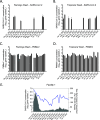Environmental Surveillance of Flood Control Infrastructure Impacted by Unsheltered Individuals Leads to the Detection of SARS-CoV-2 and Novel Mutations in the Spike Gene
- PMID: 38752195
- PMCID: PMC11095249
- DOI: 10.1021/acs.estlett.3c00938
Environmental Surveillance of Flood Control Infrastructure Impacted by Unsheltered Individuals Leads to the Detection of SARS-CoV-2 and Novel Mutations in the Spike Gene
Abstract
In the United States, the growing number of people experiencing homelessness has become a socioeconomic crisis with public health ramifications, recently exacerbated by the COVID-19 pandemic. We hypothesized that the environmental surveillance of flood control infrastructure may be an effective approach to understand the prevalence of infectious disease. From December 2021 through July 2022, we tested for SARS-CoV-2 RNA from two flood control channels known to be impacted by unsheltered individuals residing in upstream tunnels. Using qPCR, we detected SARS-CoV-2 RNA in these environmental water samples when significant COVID-19 outbreaks were occurring in the surrounding community. We also performed whole genome sequencing to identify SARS-CoV-2 lineages. Variant compositions were consistent with those of geographically and temporally matched municipal wastewater samples and clinical specimens. However, we also detected 10 of 22 mutations specific to the Alpha variant in the environmental water samples collected during January 2022-one year after the Alpha infection peak. We also identified mutations in the spike gene that have never been identified in published reports. Our findings demonstrate that environmental surveillance of flood control infrastructure may be an effective tool to understand public health conditions among unsheltered individuals-a vulnerable population that is underrepresented in clinical surveillance data.
Keywords: COVID-19; Cryptic mutations; SARS-CoV-2; Spike; Stormwater; Wastewater.
Conflict of interest statement
The authors declare no competing financial interest.
Figures


References
-
- Kirby A. E.; Walters M. S.; Jennings W. C.; Fugitt R.; LaCross N.; Mattioli M.; Marsh Z. A.; Roberts V. A.; Mercante J. W.; Yoder J.; Hill V. R. Using Wastewater Surveillance Data to Support the COVID-19 Response - United States, 2020–2021. MMWR Morb Mortal Wkly Rep 2021, 70 (36), 1242–1244. 10.15585/mmwr.mm7036a2. - DOI - PMC - PubMed
-
- Ahmed W.; Angel N.; Edson J.; Bibby K.; Bivins A.; O’Brien J. W.; Choi P. M.; Kitajima M.; Simpson S. L.; Li J.; Tscharke B.; Verhagen R.; Smith W. J. M.; Zaugg J.; Dierens L.; Hugenholtz P.; Thomas K. V.; Mueller J. F. First Confirmed Detection of SARS-CoV-2 in Untreated Wastewater in Australia: A Proof of Concept for the Wastewater Surveillance of COVID-19 in the Community. Science of The Total Environment 2020, 728, 13876410.1016/j.scitotenv.2020.138764. - DOI - PMC - PubMed
-
- Weidhaas J.; Aanderud Z. T.; Roper D. K.; VanDerslice J.; Gaddis E. B.; Ostermiller J.; Hoffman K.; Jamal R.; Heck P.; Zhang Y.; Torgersen K.; Laan J. V.; LaCross N. Correlation of SARS-CoV-2 RNA in Wastewater with COVID-19 Disease Burden in Sewersheds. Sci. Total Environ. 2021, 775, 14579010.1016/j.scitotenv.2021.145790. - DOI - PMC - PubMed
Grants and funding
LinkOut - more resources
Full Text Sources
Miscellaneous
